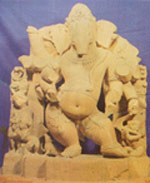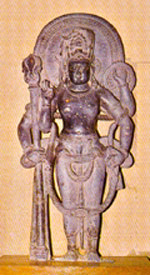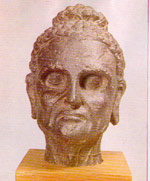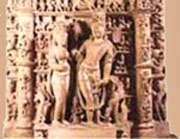

The Museum houses about two thousand stone sculptures from circa 3rd century B.C. to the 14th century A.D. These hail from various sites stretching from the ancient Gandhara regions (modern Afghanistan and Pakistan) to Bengal but mostly represent the so called Ganga- Yamuna valley. Made in various kinds of stone such as schist, slate, sand stone (red and buff), lime, chlorite, basalt and granite, the pieces include divine and semi-divine figures related to Hindu, Buddhist, Jaina and Folk religions of India. Of these sculptures, a few being inscribed are historically important. There are some sculptures which betray rare iconography of certain divinities. There are also some sculptures which were relieved with fascinating narratives and finally, there are quite a few which are artistically beautiful and pleasing.
The Museum has in its collection a few ring stones. Executed superbly,
these small ring stones are dated between c. 3rd century B.C. and lst
century B.C. Carved in Chunar sand stone, these were mostly collected
either from Rajghat in Varanasi or from Kausambi near Allahabad. Some
of these have a hole in the middle while others are devoid of it. Decorated
with floral and vegetal motifs and animals, a few of these indicated
the standing figure of a mother goddess. The scholars ascribe their
relations with solar symbolism and the cult of mother goddess and consider
these as symbols of Sakti worship. The Museum also possesses a number
of fragmentary pieces of pillar capitals. Belonging to the Asokan period,
these stone pieces came as gifts from the Archaeological Survey of India,
Sarnath region.
The sculptures belonging to the Sunga period (2nd- Ist cent. B.C.) are
very few in number and the Museum has some fragmentary pieces from the
Buddhist Stupa railings of Bharhut in Central India. These include fragment
of pillar (thabha), a few crossbars (suchi) and the fragment
of coping stone (ushnisha). Of these, mention may be made of
an inscribed crossbar (SUChl) that incorporates the story of
a Whale (timingila) in which a big whale, promted by the sense
of non-violence is shown emitting out with great pain, an already swallowed
boat with its passengers. Of other notable pieces of the period, mention
may be made of the figure of Trimukha Yaksha from Rajghat and winged
dear and horse on either side of a crossbar from Ahichchhatra.
The Museum has
a sizeable collection of sculptures of the Kushana period (lst to 3rd
century A.D.). These include images of Surya, Mahishasurmardini, Kubera,
Hariti, Harihara, Mukha-Linga and Agni. It has also a number of fragments
related to Buddha, Bodhisattva and Jaina figures. However, the most notable
and outstanding piece of this period presented in the gallery is the figure
of so called toilet bearer (prasadhika). Identified variously as
the figure of Goddess of Fortune(Lakshml) or as denoting a River goddess
(Nadi-matrika), this sculpture in the round hails from Faizabad
in Uttar Pradesh. Made in spotted white red sandstone, this extremely
beautiful sculpture was made in Mathura and was possibly brought to Faizabad.
Evidently conceived in movement, this sculpture projects the body of a
young woman, carefully and tastefully attained with subdued sensitivity
and poise.
She bears a charming yet mysterious smile and thereby, became extremely
attractive.
The Museum has a single piece
of this period hailing from Andhra Pradesh which is ichnographically very
important. The fragment of a crossbar on display made in lime stone hails
reportedly from Amaravati and records the narrative of the taming of Nalagiri.
A second version with more details is in the collection of Government
Museum, Madras. The Museum possesses in its collection fifty-four pieces
of sculptures from Gandhara regions. These include stone sculptures and
stuccoes. Of these, mention may be made of a fragment of a bust of Mayadevi.
When intact, this was related to the depiction of the birth of Siddhartha.
Besides, the collection includes two emaciated detached heads of Bodhisattva
one of which is displayed in the gallery; this was caused due to his fasting
and observation of austerities in search of salvation. The figure of standing
Bodhisattva Maitreya and the seated Bodhisattva in Princely attires are
notable of this region.
A number of beautiful sculptures are there in this collection belonging to the classical art of Gupta period (4th -6th century A.D.). These images are mostly the productions of either Mathura or Sarnath School of sculptures. There are also notable pieces hailing from the city of Banaras and from Bihar. Related to the Mathura School, the Museum has beautiful Buddha heads, head of Harihara and the head of Ardhanarisvara. A number of Buddha images and heads also hail from Sarnath. From Banaras, the Museum could collect a monumental image of Govardhanadhari Krishna displayed in the Central Hall, a fascinating image of Kartikeya in the gallery seated on his mount peacock, two inscribed pillars with Visnavite figures from Rajghat, a few Buddha images and a panel in the gallery showing stealing of butter by Lord Krishna.
From Shahabad, Bihar hails one of the finest images of Indrani. This image bears an aristocratic aloofness in her bearings and holds a thnderbolt (vajra) and a pomegranate in her hands. As the spouse of Indra, sahasraksha (thousand eyed one), the Indrani bears a number of eye on the upper part of her body including a eye on her forehead. The images of Hari-hara represents the blend of characteristics of two important gods viz. Vishnu and Siva. The left has the emblems of Vishnu like crowm , disc and conch. While siva is to be recognised by matted hair, crescent, rosary, trident. This rather unique and beautiful image is carved in the schist stone and hails from the Ganganagar region in Rajasthan.
The collection includes a number of notable images from central, north and eastern India which are either ichnographically important or aesthetically pleasing or both. Of these mention may be made of a few displayed images including a dancing image of child Ganapati from Kanauj, U.P. dated 9th century A.D. , the damages panel of a Jyotirlinga from Etah , U.P. dated 10th century A.D. and the panel showing Marriage of Siva also from Etah, U.P. dated in the 10th-11th century A.D. The Lady in Languor (Alasa-kanya) and the figure of Dikpala Isana from Khajuraho, Central India dated in the 10th-11th century are no less remarkable. A few Visnu images and his incarnatory forms specially, the Tortoise incarnation (Kurma-avatara) and Boar incarnation (Varsha-avatara) from Bihar and Bengal belonging to 10th-12th century are ichnographically as well as from the point of regional expressions of Pala-Sena periods are worthy enough to note. A few late images including the figures of Batuka Bhairava and Jyestha of South Indian origin are ichnographically quite interesting and are on display in the gallery.



